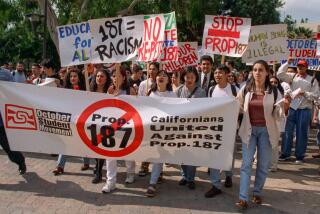Census May Have Skipped 8.3 Million, Studies Show : Population: Possibly overlooked are 1.5 million in California. They could give state new congressional seat.
- Share via
WASHINGTON — As many as 8.3 million Americans, including up to 1.5 million Californians, were overlooked in the 1990 census, according to preliminary conclusions from two sets of research released Thursday by the Census Bureau.
The new information gleaned from the two studies undoubtedly will bring to bear more political pressure on the government to adjust the census, as big-city mayors, minority advocates and some governors have urged in court and other public forums.
The studies also indicate that minorities--notably blacks and Latinos--were disproportionately undercounted. However, the Census Bureau said that conclusion may be skewed by the fact that many people listed their race as “other” and that further study is needed.
The 1990 Census lists the nation’s total population as 248,709,873. But the Post Enumeration Survey figures estimate that the total is higher by between 4,272,127 and 6,279,127. The second study based on demographic records concluded that the census missed between 4,101,127 and 8,254,127 people living in the country.
Census data is used for reapportioning the 435 seats in the U.S. House of Representatives and seats in state legislatures. In addition, population-based formulas are used in many cases to allocate federal revenues to state and local governments.
If the two studies spur adjustments in census figures, California is likely to gain at least one more congressional seat beyond the seven additional ones already called for, said Leo Estrada, a demographer at UCLA who will make recommendations about the adjustment to the Census Bureau.
Estrada also predicted that Georgia and Montana likely would gain another seat each, while Wisconsin, Pennsylvania and Oklahoma each likely would lose yet another.
Under a court agreement, Commerce Secretary Robert A. Mosbacher has until July 15 to decide whether to adjust the census figures. But the lobbying for an adjustment began almost immediately.
“I think it does put a lot of pressure on him (Mosbacher),” said Rep. Thomas C. Sawyer (D-Ohio), chairman of the House census and population subcommittee. “This simply reconfirms the concerns we’ve had all along. We’ve been worried that many more people were missed in 1990 than in 1980.”
Lance Simmens, assistant executive director of the U.S. Conference of Mayors, agreed. “I don’t find the release of these figures very comforting,” he said after the bureau’s news conference announcing the data. “I think they prove our point--an undercount has occurred and must be corrected.”
One of the studies released Thursday is the Post Enumeration Survey. In this study, census takers sampled 165,000 households already visited by enumerators during the original census count. In the survey, bureau officials compared the original census and the figures collected later and then projected both a high and low range estimate of how many people were overlooked.
Lewis Kincannon, deputy director of the census, told reporters during a briefing that another set of definitive numbers will be released next month. He emphasized that the figures released Thursday are “subject to several sources of error” and will be further studied.
The second study was based on an analysis of birth and death certificates and other demographic and administrative records on file with the government.
Worried that an undercount of their population would result in a loss of political clout in Washington as well as federal dollars, Los Angeles and other cities sued the bureau two years ago to compel it to adjust the census for expected undercounts, especially among the poor and minority groups who tend to evade census counters.
A settlement of the suit resulted in the Administration’s agreeing to consider using the Post Enumeration Survey as a sample for adjusting the 1990 census for a possible overcount or undercount.
Bureau officials conceded that the 1990 census missed millions of Americans, even as they questioned the wisdom of using the new numbers. “We know we have the symptoms of a census undercount,” Kincannon said. “But we have to make sure the cure is not worse than the symptoms.”
In California, the post-enumeration figures showed a range of 30,578,000 to 31,241,000 residents--well above the census’ 29,760,021. The bureau did not release a state-by-state breakdown for the second study.
Bill Chandler, a spokesman for Los Angeles Mayor Tom Bradley, said: “The figures released today showing a substantial undercount prove exactly why the mayor and other city leaders wanted a post-census survey taken.”
Although the bureau did not release undercount estimates for individual cities, Chandler estimated that the census missed “anywhere from 100,000 to 250,000 people . . . that would seriously affect the city’s ability to qualify for federal funds and thereby provide service to our residents.”
The analysis of the preliminary figures from the two studies assumes that the midpoint between the high and low estimates is the “best guess” of the actual undercount. Employing that yardstick, the post enumeration figures indicate that the 1990 census missed about 2% of the nation’s population or about 5.3 million people. Census officials said that the 1980 census missed about 1.8% of the population.
The discrepancy between the 1990 census and the new figures is more stark when race is factored into the equation. About 5.5% of the nation’s 30 million black residents were uncounted, the post-enumeration figures show. The demographic figures show a 7% black undercount, up from a comparable 4.7% in 1980.
Staff writer Frank Clifford in Los Angeles contributed to this story.
More to Read
Get the L.A. Times Politics newsletter
Deeply reported insights into legislation, politics and policy from Sacramento, Washington and beyond. In your inbox three times per week.
You may occasionally receive promotional content from the Los Angeles Times.










